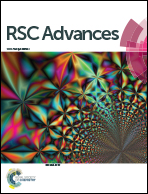A study of the biodegradation behaviour of poly(methacrylic acid/aniline)-grafted gum ghatti by a soil burial method
Abstract
Gum ghatti-based cross-linked hydrogels have been studied for their water absorption, flocculation and biodegradation properties. To date, a lot of research has been focused on gum ghatti-based cross-linked hydrogels; however, the synthesis and characterization of gum ghatti-based conductive biomaterials are relatively less explored. Moreover, the biodegradation and moisture retention studies have not been reported for conductive hydrogels. A gum ghatti-based electrically conductive hydrogel was prepared through a two-step aqueous polymerization. Biodegradation studies of the synthesized hydrogels were conducted using a soil burial test. Interpenetrating network structures showed better degradation efficiency than semi-IPN. The weight loss of semi-IPN and IPN was 66% and 86.6%, respectively, in 60 days. Different stages of degradation were studied using FTIR and SEM techniques. Furthermore, application of hydrogels to improve the water retention properties of different soils was studied for agricultural purposes, and it was found that the IPN hydrogel can improve the moisture retention capacity of soil for cultivation.


 Please wait while we load your content...
Please wait while we load your content...